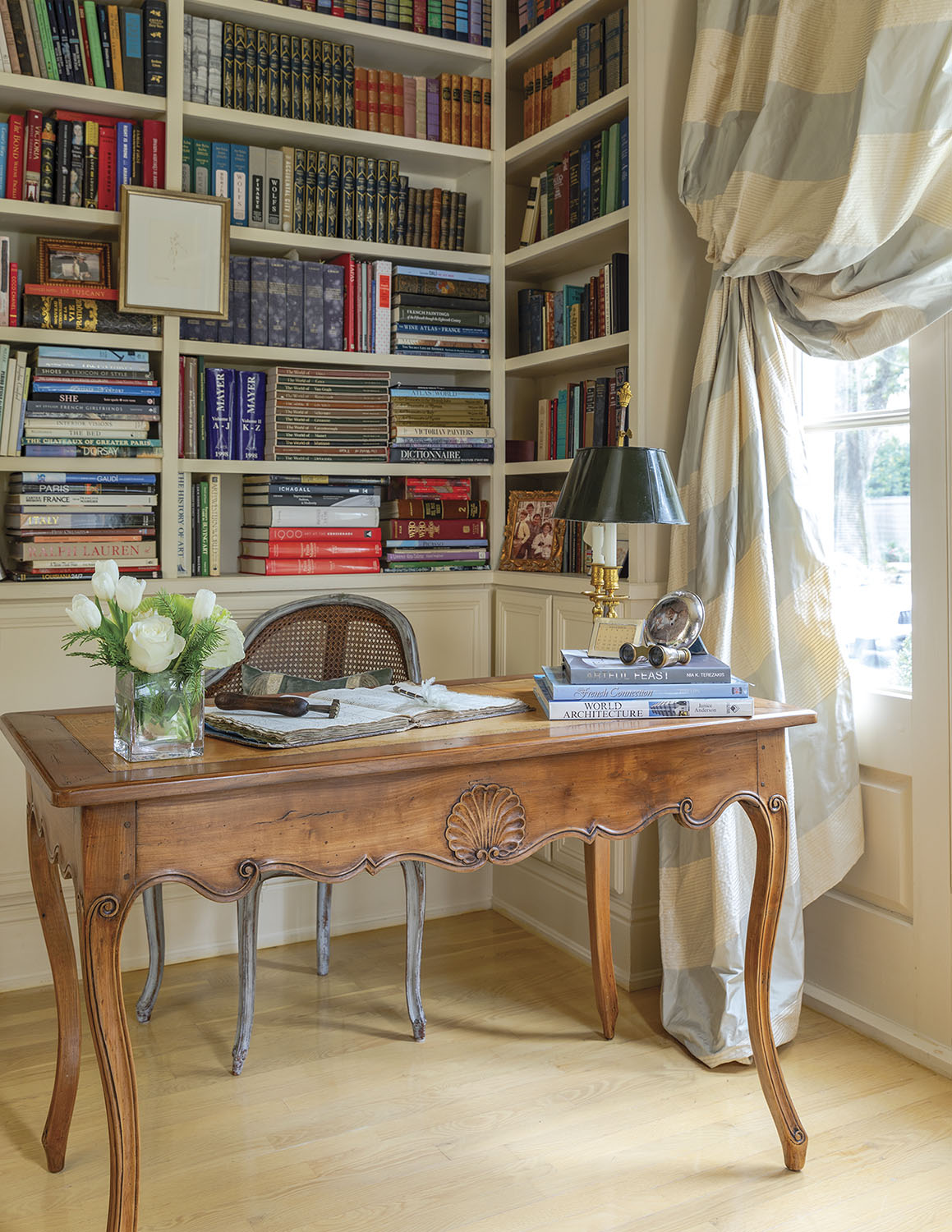
The family room’s limestone fireplace is an authentic representation of the classic château-style fixture common in Provençal architecture. Antique walnut boiserie panels were retrofitted as closet doors. Kumquats, pomegranates, and decorative cabbage enhance the garden-fresh flavor of the room, which is situated between the kitchen and the back porch.
It is the simplicity and authenticity of the Provençal style that has inspired Alix’s designs for decades—and not just during the holidays. For 25 years, the interior decorator and her husband, Paul, a photographer, have split their time between a 17th-century townhouse in the idyllic village of Goult and their primary residence, a 1930s cottage in New Orleans. Once described as a “cookie-cutter brick box,” the home in their beloved Old Metairie neighborhood was purchased in an effort to downsize.

At the entry of Alix Rico’s New Orleans home, topiaries, foliage, and flowers, including paperwhite, cyclamen, and alyssum, are corralled in urns and pots made by artisans in L’Isle sur la Sorgue in France.

Interior decorator Alix Rico in the kitchen of her Provence-inspired home in New Orleans. “The French don’t ‘save the good stuff’ for special occasions. They love what they have, so they use it. They don’t see a chip on a plate or a patch of tarnish on the silver as a flaw, but as a sign of a life well lived," she says.
“I prefer a light touch,” says Alix of the ethereal palette. “That’s reflected in the drapes, upholstery, and rugs that I surround myself with every day, so why would I go with red and green come December? My wintry mix of pure white and shiny silver speaks to my aesthetic regardless of what the calendar says.”

Michael the Archangel, recovered from a chapel, watches over the living room from a Louis XV walnut table.

A medley of white flowers and greenery spills from an 18th-century giltwood corona that reigned above a life-sized church statue in its former life. “It’s one of my absolute favorite finds,” says Alix.
SCENES FROM ALIX’S PROVENÇAL-INSPIRED HOME

A fresh cone-shaped topiary flocked with doves and white flowers stands in lieu of a traditional Christmas tree in the foyer. An 18th-century painted putto keeps vigil atop a Louis XV giltwood stool. A 19th-century oil painting by Henri Daudin hangs above a Directoire recamier.

Osborne & Little wallpaper panels applied to the ceiling create a canopy of stars above the four-poster bed in the main bedroom.

An 18th-century giltwood Madonna basks in the glow of white lights and candles on gilt altar sticks, all set in a garland of evergreens peppered with lilies, garden roses and tulips.

Paired with a suite of Louis XV cane chairs, the antique walnut refectory table hosts intimate suppers and grand dinner parties when extended to 13 feet. An antique vaisselier holds a collection of Provençal pottery.

Between the two of them, Alix and Paul have hundreds of books on art, poetry, and design.

Osborne & Little wallpaper panels applied to the ceiling create a canopy of stars above the four-poster bed in the main bedroom.
THE PROVENÇAL FEAST
Following the meal, a wine-filled coupe referred to as Sauvé Chrétiens (Save the Christians) is passed around the table. According to local lore, a sip from the communal cup will warm and fortify celebrants as they walk in the cold night air to the village church. After the service, they arrive home to a bountiful spread of 13 desserts awaiting on a table draped with three white tablecloths in honor of the Holy Trinity. The desserts, representing Christ and his 12 apostles, include an assortment of nuts, fresh and dried fruit, quince cheese, and black and white nougat. Freshly baked olive oil bread, or gibassier, is accompanied by calissons, a candied fruit paste, and navettes, little boat-shaped cookies flavored with orange-flower water imported from the capital city of Marseille.
This story originally appeared in Flower magazine’s Nov/Dec 2020 issue. Subscribe to the magazine or sign up for our free e-newsletter.





